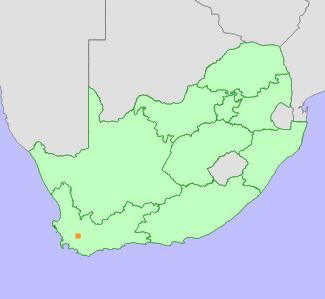|
Scientific Name | Disa remota H.P.Linder |
Higher Classification | Monocotyledons |
Family | ORCHIDACEAE |
National Status |
Status and Criteria | Rare |
Assessment Date | 2012/08/29 |
Assessor(s) | L. von Staden |
Justification | A localized habitat specialist currently known from a single collection. In addition to its habitat being very rugged and inaccessible, this species flowers only after fires, and is therefore likely to be overlooked. Its habitat is protected and it is not threatened. |
Distribution |
Endemism | South African endemic |
Provincial distribution | Western Cape |
Range | This species is found in Fonteintjiesberg between Worcester and Ceres. |
Habitat and Ecology |
Major system | Terrestrial |
Major habitats | South Hex Sandstone Fynbos |
Description | Plants grow in damp ledges on cliffs on north-facing slopes. |
Threats |
| This species' habitat is protected and it has no known threats. |
Population |
This species was discovered in 2003, and is to date known only from a single collection. At the time of discovery, only two plants could be found, however, this species occurs in very rugged terrain that has been poorly explored. In addition, it belongs to Disa section Disella, a group of species that flower only in response to fire. It is therefore very likely that other, undiscovered subpopulations exist elsewhere in the Hex River Mountains.
|
Population trend | Stable |
Assessment History |
Taxon assessed |
Status and Criteria |
Citation/Red List version | | Disa remota H.P.Linder | Least Concern | 2012.1 | | Disa remota H.P.Linder | Least Concern | Raimondo et al. (2009) | |
Bibliography |
Linder, H.P. and Hitchcock, A.N. 2006. Disa remota, a remarkable new orchid species from the Western Cape. South African Journal of Botany 72(4):627-629.
Raimondo, D., von Staden, L., Foden, W., Victor, J.E., Helme, N.A., Turner, R.C., Kamundi, D.A. and Manyama, P.A. 2009. Red List of South African Plants. Strelitzia 25. South African National Biodiversity Institute, Pretoria.
|
Citation |
| von Staden, L. 2012. Disa remota H.P.Linder. National Assessment: Red List of South African Plants version 2024.1. Accessed on 2025/10/30 |
 Comment on this assessment
Comment on this assessment


